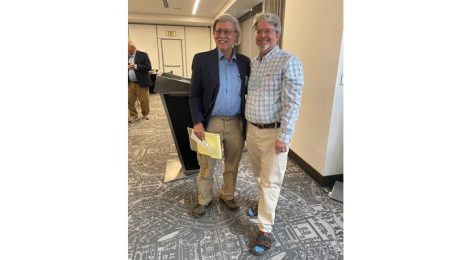
2024 General Tools Award Winner – Mike Raber
MIKE RABER
Few, if any, currently active SIA members have done more professional work in industrial archeology than Michael Raber. Since 1980, he has run Raber Associates, a highly successful consulting firm specializing in cultural resource management with an emphasis on industrial sites. He has been principal or co-principal investigator and the primary report writer for well over 400 assessments, master plans, archaeological surveys or excavations, preservation management plans, interpretive signage exhibits, National Register evaluations and nominations, and HAER documentation projects.
He has also published numerous articles and several books on industrial topics and has served the SIA in many ways, giving frequent presentations, developing tours, and serving on the Society’s Nominations and General Tools award committees.
Mike earned three degrees from Yale University, culminating with a Ph.D. in Anthropology, but he never aspired to be an academic. Instead, his chosen vocation has been contract work in archaeology and planning. The incredible range of projects that he has directed testifies to his versatility, technical expertise, and insatiable curiosity. At least three previous winners of the General Tools Award (Pat Malone, Robert Gordon, and Chuck Parrott) have been close collaborators on his projects. Gerry Weinstein, whose tool and instrument company established the award, has been a recording photographer with Raber Associates for decades. Other SIA members (including John Bowie, Carol Cooper, Bill Johnson, Tom Flagg, Greg Galer, Matt Roth, Ned Connors, and the late Tom Leary) have been valuable contributors to Raber’s cultural resource teams. Most of Mike’s work has been in the Northeast, but he also completed notable projects in Virginia (Tredegar Ironworks) and Ohio (Muskingum Canal/River Navigation).
Versatility is one of Mike Raber’s greatest strengths. If he has specialties, they are waterpower features (including dams, gates, and raceways), canals and river navigation systems, and metalworking operations. Production of small arms, ammunition, and other military equipment has also drawn a great deal of his attention. One example is his work on the Boston Naval Shipyard and its unique chain forge for the National Park Service.
He brings boundless enthusiasm and energy, not only to his professional work, but also to his participation in SIA conferences. He achieved a remarkable level of efficiency in the counting of paper ballots for the Nominations Committee, an onerous task that used to be completed the night before the Society’s business meeting. One of his proudest accomplishments was finding a sharp letter opener that greatly sped up the process and avoided paper cuts on clumsy fingers.
As a gifted writer, map maker, and designer of tables, Mike always takes the lead in the completion of lengthy reports from Raber Associates. His most impressive ability, however, is managing the work of other industrial archaeologists, who often have strong opinions about the sites and artifacts under investigation. Mike’s editorial and diplomatic skills are of such a high order that he can turn a diverse set of individual contributions into seamless, polished assemblages that satisfy everyone involved.
A fine example of Mike’s editorial skill is the IA theme issue on the Springfield Armory (Vol. 14, No. 1, 1988). A much longer, detailed report for the National Park Service had already earned high praise. For the theme issue, Mike used four separate articles (and numerous photographs) by the team members in that NPS study. He also organized sessions at an SIA conference to share the results of the study, which became the basis for the IA theme issue. Mike assisted with the content and graphic design of his collaborators’ thematic articles before copy editing them masterfully and adding his own overview covering the Armory’s operation from 1794 to 1918.
The intricate site maps in the Springfield Armory issue were products of Mike’s collaboration with a cartographer (Lyn Malone). Throughout his career, Mike has excelled in surveying, map-making, artifactual analysis (even to the microscopic level), and the use of historical maps. He is particularly effective in producing new sequences of maps illustrating site development over time. He worked with Lyn Malone to create a set of ink-on-mylar overlays showing changes in the pattern of piers along the Hudson River waterfront of Manhattan’s Upper West Side. Later Mike and Lyn switched to computer aided design (CAD) to represent a challenging sequence of maps demonstrating the complex history of the Tredegar Ironworks site. Relying on earlier plans and aerial photographs as well as highly accurate surveying and field recording, they produced CAD layers that tracked every significant change in Tredegar’s many buildings and raceways.
One of the Springfield articles won the SIA’s Norton Prize (now Vogel Prize), an award that Mike had already received for an article he co-wrote with Robert Gordon entitled “An Early American Integrated Steelworks” (IA, Vol. 10, No. 1, 1984). As Gordon shared: Recording what appeared to be the ruins of yet another a stone blast furnace in Roxbury, Connecticut, Mike uncovered the site of one of the earliest successful attempts at making crucible steel in the U.S. Exploration of the Mine Hill furnace site quickly showed Mike that this was just one part of a large industrial complex that included an underground mine, ore preparation and roasting facilities, crucible furnace foundations, and traces of a rolling mill. As a result of Mike’s documentation, the Roxbury Land Trust was able to create a large town preserve with the industrial archeology interpreted for visitors, and with a network of hiking trails.
Throughout his career, Mike Raber has demonstrated excellence in his field work, excavation skills, and archival research and his development of informative tours and creative signage for site interpretation. He’s shown a willingness to take physical risks—in buried raceways, among operating machines, in bucket hoists, and on the crests of dams. His dedication to industrial archeology is genuine and long-lasting and enriches our cultural heritage now and will do so for decades to come. It’s my honor to announce the winner of the Society for Industrial Archeology’s General Tools Award for 2024: Mike Raber.
— Adapted from the award citation Christopher Marston delivered at the SIA’s 2024 Annual Business Meeting, which was held on May 18, 2024

